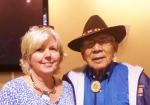
A few years ago, I had the privilege to travel in and around Cherokee, North Carolina. My daughter and I chose to spend a morning at the Museum of the Cherokee Indian. Here we not only met but also sat and listened to a great storyteller and renowned Beloved Man, Jerry Wolfe. Mr. Wolfe was 92 years young at the time, the first man to have received the honorable title ‘Beloved Man’ among Cherokee in over 200 years. It was well-deserved. He was a World War II veteran, a survivor of D-Day on Normandy, a stonemason who lay stone throughout the Smoky Mountains, and a dedicated volunteer who spent time with children, teaching them Cherokee stories, language, ways and games. He volunteered daily in the museum, greeting visitors and giving talks. That’s where we mer him. His interest shifted readily from what he was reading (a New Testament, written in Cherokee language Tsalgi) to the visitors entering the museum.

Yours truly with Beloved Man Jerry Wolfe, a year before his passing.
He told us delightful stories. He shared traditional Cherokee stories, woven like fables, with funny twists and important lessons.
After listening to his wonderful stories, we slowly meandered through the museum. Here we found a beautiful talking stone with the Cherokee syllabary engraved and backlit. As each “letter” lit up, museum visitors heard a recording of its sound.
Did you know that rather than an alphabet, the Cherokee have a syllabary? What’s a syllabary, you ask? A syllabary is a set of syllables that make up the language. The Cherokee syllabary was developed and published between 1815 and 1821 by Sequoyah (English name George Guess). After trying to devise pictures for each Cherokee word, he realized the task was too much. Instead, he thought long and hard about the syllables that made up each word and identified 86. This made symbol creation feasible. He soon taught his brother and daughter the new form of communication.
Before long, Sequoyah was arrested and stood trial for sorcery, which could have been the end of him. During the trial, his people saw that he and his daughter were able to communicate with one another by making symbols on pieces of paper. His captors soon helped him spread the news to their people.
As it turns out, the syllabary is a remarkably easier way to learn to read and write a language. Students learning the syllable forms could learn to read and write in a few weeks as compared to our years of study. Within a matter of months, a great number of Cherokee in this time became literate. By 1824 most Cherokees could read and write using this syllabary. By 1828 both the Cherokee Phoenix and the Cherokee Advocate, regularly published newspapers, employed this syllabary and publishers in Boston worked toward translating it into print for the Bible and other notable works.
It is the language of some of my ancestors, but it is long forgotten in my family’s line. It is a language of harmony with nature, with one another, and with the Great Spirit. It is a language that is coming back again.
For too long, Cherokee, as other indigenous peoples to this land, were suppressed. Our American forefathers forced them into schools in an effort to eradicate their language and culture. As recently as the 1900’s, our government leaders and respected professionals took part in what was no more than a witch-hunt to identify and isolate from mainstream white America any who were part “Indian,” and categorizing them as Blacks, discriminating equally against the two groups so they could not receive government assistance, schooling or medical care.
Imagine what that would be like to us today, to have a foreign invader come and force their way upon us–or death. It is incomprehensible. Yet this is what happened to the indigenous people, here, in America, when this country, which stands for freedom, began.
It is no wonder that so many Cherokee and other indigenous people found refuge by blending in with their European spouses and families, and kept their heritage to themselves. It was a matter of survival, a matter of securing their hope for the future; for their children.
All the years of oppression left the Cherokee in a poor state, with rampant alcoholism, poverty and poor health. This is the stereotype. But they are returning. Their pride is returning. Their language is returning. Their culture is returning. There is something special about this people. They hold truths which will be vital in restoring our nation–even our world.
Tell me–are you descended from indigenous people in America? How has that deepened or enriched your life? I’d love to hear your stories, heart to heart.
Joan T. Warren
Addendum: As an occupational therapist, I’ve been privileged to help many a child master writing the alphabet, sentences and paragraphs. If you’d like to see another alphabet photo challenge, visit my newest blog, OT Interactions.
